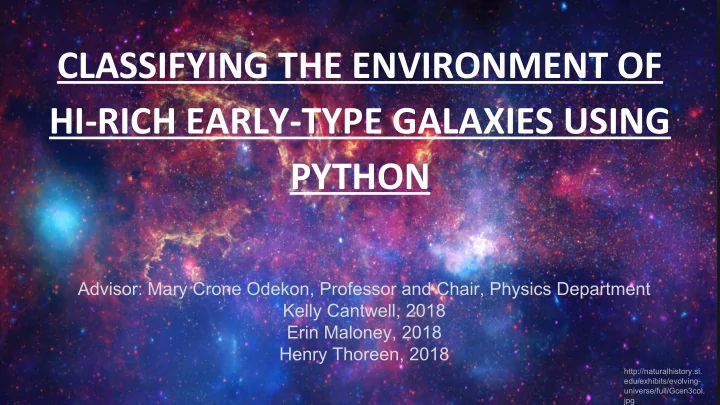

CLASSIFYING THE ENVIRONMENT OF HI-RICH EARLY-TYPE GALAXIES USING PYTHON Advisor: Mary Crone Odekon, Professor and Chair, Physics Department Kelly Cantwell, 2018 Erin Maloney, 2018 Henry Thoreen, 2018 http://naturalhistory.si. edu/exhibits/evolving- universe/full/Gcen3col. jpg
Overview -Galaxies Background ★ -Project Goals ★ -Our Programs ★ -Future Plans ★ https://www.reddit. com/r/DotA2/comments/3545t2/f un_little_facts_about_the_new_b lack_hole/
Galaxies Background Two type of galaxies: ★ ○ Early-Type Galaxies (ETG) ○ Late-Type Galaxies (LTG) Early-Type Galaxies typically have elliptical morphology ★ http://www.wolaver. and little to no new stars forming org/space/M87.jpg ○ ETG refers to older galaxies, with stars that formed earlier in the history of the universe ○ More red in color, less bright Late-Type Galaxies typically have spiral morphology ★ and lots of new star formation ○ LTG refers to younger galaxies, with stars that are still forming in the late era of the universe ○ More blue in color, very bright http://i1.wp.com/www. universetoday.com/wp- content/uploads/2013/10/milky_wa y.jpg?resize=350%2C200
Galaxies Background (cont) How to locate things on the sky: ★ ○ Right Ascension (east vs west) ○ Declination (north vs south) ○ Red Shift (radially out) Right Ascension (RA): ★ ○ How far to the right of the Prime Meridian ○ Measured in hours, minutes and seconds Declination (Dec): ★ http://www.uwgb. ○ Angular distance (north/south) from the celestial equator edu/dutchs/Graphics- Geol/Astronomy/RA- ○ Measured in degrees Dec.gif Red Shift ★ ○ The shift of light waves towards longer wavelengths or “red-er” wavelengths ○ Used in astronomy as a radially outward distance measure, measured in km/s/Mpc
Galaxies Background (cont) HI Gas ★ ○ Neutral Atomic Hydrogen Gas What does it usually mean? ★ ○ Indicates new star formation ○ Often found in LTGs http://hyperphysics. phy-astr.gsu. edu/hbase/quantum/im How do we detect it? ★ gqua/h21.gif ○ Emits 21 cm wavelength (1420.4 MHz) - radio waves! ■ Transition between atomic spin ½ states while in the ground (1s) state ○ Use radio telescopes to detect it -- Arecibo and Green Bank Why do WE look at it? ★ ○ Some ETGs have HI gas, this is abnormal ○ Trying to figure out WHY the HI is present in these ETGs
Project Goals: ★ Find ETGs with large amounts of HI gas ★ Look at the environment of these “abnormal” ETGs ★ Try to find a correlation between HI-rich ETGs and galaxy environment using Python coding http://www.spaceanswers.com/deep-space/this-is-what-two-colliding-galaxies-look-like/
Python (the coding language for parseltongue enthusiasts) Existing Python codes needed to be ★ debugged before they could output necessary calculations Step one: learn Python 2.7! ★ http://www.learnpythonthehardway.org/ ★ (no, not this type of python) ★ http://kaijutegu.tumblr. com/post/134642306048/umblyun- kaijutegu-umblyun-submitted-im
Code Programs 3 Programs that we worked on: ★ ○ 2 needed modification ■ Nearest Neighbor Density ■ Large-Scale Environment ○ 1 new ■ Galaxy Matching http://www.answers. com/article/523004/unlock-the- code-what-the-computer-codes-for- cars-really-mean
Nearest Neighbor Density Program Helps classify the local environment of each galaxy ★ Needed debugging ★ https://www.youtube.com/watch? Calculates the 3rd neighbor density for each galaxy ★ v=NESNKdybWGk ○ Divides the area of a circle with radius of the distance to the third closest galaxy by 3 Calculates the average density ★ ○ Calculates then sums the densities for the second through the tenth closest galaxies, then divides by 9 Calculates the 3rd to average ratio ★ ○ Shows the uniformity (or lack thereof) of the local density of each galaxy
Large-Scale Environment Program Classifies the large scale environment of each galaxy into groups, filaments, ★ tendrils, and voids ○ Uses the graph method of Minimal Spanning Trees to find the filaments and tendrils using the groups as nodes Needed modification ★ ○ Input and implementation too complex for practical use
Galaxy Matching Program Matches known galaxies detected optically with those in our catalog (detected ★ in HI) Calculates the projected distance from the HI detection to the nearest known ★ galaxy and assigns the density values of that galaxy to the HI galaxy detection Considers only galaxies with a recessional velocity difference of less than ★ 1000 km/s ○ Here recessional velocity is c*Z, or speed of light times the redshift ○ (can be thought of as the 3rd dimension for a 3D distance calculation)
Next Steps
References ★ Jones, Michael G.; Papastergis, Emmanouil; Haynes, Martha P.; Giovanelli, Riccardo, 2016, MNRAS, 457, 4393 Shaw, Zed; Learn Python the Hard Way ★ 3rd Edition; http://learnpythonthehardway. org/book/ ★ Barrow, John D. et al, 1985: Minimal Spanning Trees, Filaments, and Galaxy Clustering Alpaslan, Mehemen et al, 2013: Galaxy ★ and Mass Assembly (GAMA): The large scale structure of galaxies and comparison to mock universities ★ http://www.deviantart. com/art/Quasar- 211879065
Acknowledgements Skidmore College Student/Faculty Collaborative Research grant Sloan Digital Sky Survey DR7 Schupf Scholars program National Science Foundation AST Award 1211005 Arecibo and Green Bank http://www.australianscience.com. au/wp-content/uploads/2012/03/Earth- from-the-Moon-photo-credit-NASA.jpg
THANKS FOR LISTENING! (pls can we keep this??) --we’ll ask Mary -.- https://www.youtube.com/watch?v=ykWPyaqbebo Crab Nebula
Recommend
More recommend